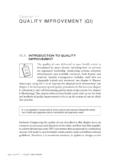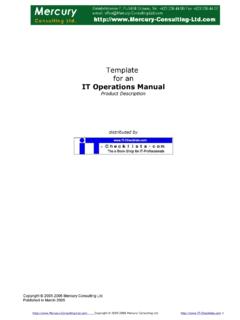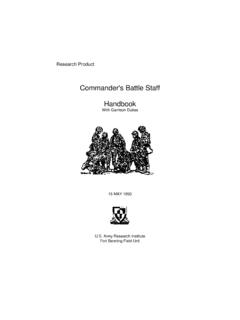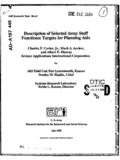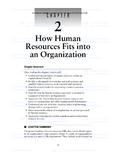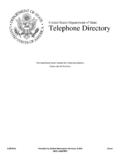Transcription of Operations Risk - Risk Assessment - World Bank
1 11 OPERATIONAL RISKRISK ASSESSMENT22 OVERVIEW Inherent Risk Risk Management Composite or Net Residual Risk Trend33 INHERENT RISK Definition Sources Identification Quantification44 DefinitionOPERATIONAL RISK DEFINED The risk of direct or indirect loss due to inadequate or failed internal processes, people, and systems, or from external events. Basel, Sound Practices for the Management & Supervision of Operational Risk Translation: Everything that s not credit and market SourcesSOURCES OF RISK People Fraud Breach of authorized limits Human error Processes Execution failure Product failure Systems Systems disruption or failure Vendor/service provider failure External events Natural disaster Political events66 Risk SourcesUNDERSTANDING THE OPERATIONAL AREAP eople organization chart and reporting lines What is department s position within organization ?
2 What is department s organization structure? Clear, direct, and sufficiently high reporting lines? Interfaces with other departments What data, reports, or risk management responsibilities flow across departmental boundaries? Role definitions or job descriptions Are departmental activities and management s roles clearly defined? Staff and management qualifications What is the experience level and expertise of management and key staff?77 Risk SourcesUNDERSTANDING THE OPERATIONAL AREAP rocesses Workflow diagrams Work process documents from business line or internal audit; Management interviews Dependencies and interfaces With other internal departments; With external service providers. Products Transaction volumes and dollar amounts Risk & control assessments Procedures Monitoring reports Obtain a complete list of MIS; Identify distribution and frequency.
3 Strategy and major projects88 Risk SourcesUNDERSTANDING THE OPERATIONAL AREAS ystems Major systems and components Architecture; Hardware and software inventories System interfaces IT topologies; Data flow diagrams Outsourcing vendors Security GLBA security report for board Contingency plans Corporate contingency plan; business line and support area continuity plans99 Risk IndicatorsPERFORMANCE VERSUS RISK Performance Indicators Shorter term orientation Profit & loss or income statement derived Used by business or functional unit managers Larger number of metrics useful to more people Risk Indicators Longer term orientation Balance sheet and capital Used by executive management and the board Fewer number of metrics useful to fewer people1010 INHERENT VERSUS RESIDUAL RISK Inherent risks intrinsic to the activity Residual risks remaining after consideration of the control environment or mitigants Indicators may be of either or both types.
4 But the differences and purposes must be IndicatorsCATEGORIES FOR RISK INDICATORSB asel Categories for Operational Loss:Categories for Operational Risk: People Process Systems Events Fraud: Internal & External Employment Practices & Workplace Safety Execution, Delivery, & Process Management Business Disruption and Systems Failures Clients, Products, and Business Practices Damage to Physical Assets1212 Risk IndicatorsPEOPLE RISK INDICATORS --QUANTITATIVE MEASURES --InherentResidual Turnover rates Vacancy rates Tenure of business or functional area and senior management Organizational changes Staff size in relation to activity volumes Reliance on key staff and management succession Misuse of systems Misuse of confidential information Position vacancies and time vacant Internal fraud rates False expense claims FTE to budget1313 Risk IndicatorsPROCESS RISK INDICATORS --QUANTITATIVE MEASURES --InherentResidual Complexity Activity volumes Monetary value per transaction & in aggregate Structural changes or growth rates.
5 Merger, consolidation, integration, outsourcing New or changing product or process Fraud and operational losses Policy breaches, exceptions, and overrides Customer satisfaction Remoteness of Operations # deposit return items ACH rejects Customer and internal help desk call abandon rate Statement cycle errors % account balancing completed by deadline % new loans processed by internal goal Error rates in new products or processes1414 Risk IndicatorsSYSTEMS RISK INDICATORS --QUANTITATIVE MEASURES --InherentResidual Clarity of IT strategy Vendor dependence Mature vs. emerging technology Degree & complexity of projects Processing performance Availability and stability Capacity and scalability Level of integration Contingency planning & resiliency Access control and security Vendor performance to SLAs $-weighted or criticality-weighted project status Mainframe and network availability Capacity utilization: processing, storage, and data communication Disaster recovery response time vs.
6 Goal Volume, severity, and duration of system outages Volume, severity, and type of security incidents System response time1515 Risk IndicatorsEXTERNAL RISK INDICATORS --QUANTITATIVE MEASURES --InherentResidual Economy Competitive environment Regulatory Laws and regulations Nationalization Social unrest External/criminal threats Natural disasters Time required to reposition balance sheet or modify business activity Insurance coverage and deductible amounts Business continuity recovery time versus goal1616 Risk IndicatorsOTHER RISK INDICATORS--QUALITATIVE MEASURES --General Measures:Unique Measures: organization culture organization structure Compensation structures and incentives Systems Complexity and maturity External connectivity Centralized versus distributed Level of automation and integration Existence of quality assurance programs and metrics Internal and external Existence of comprehensive compliance risk management Geographic footprintACH Number and type of correspondents used for processing or settlements Type of transactions (WEB, TEL, RCK, ARC)Accounting/Financial Reporting Attestation / certification processesHuman Resources Hiring practices Training practicesOther Examination ratings by other regulatory bodies (nonbankingactivities)
7 1717 Risk IdentificationRISK IDENTIFICATION--INFORMATION SOURCES --General Information Sources:Financial statementsManagement reportsWebsitesOrganization chartsInterviewsAudit reports (internal and external)Media publicationsExamination reportsBrochuresCompetitors and market shareSpecialized Information Sources:Information technology schematicsEconomic studiesRegulatory publicationsIndustry studies1818 Risk QuantityINFORMATION SOURCES--GENERAL -- Accounts: number by type, growth rates Transaction: volumes by account type, individual and aggregate size, Fraud losses: stratified by account type and cause Litigation: stratified by type, exposure, and cause Error rates: granular by account type and cause Quality of performance rates and error resolution times Policy and limit breaches Geographic footprint1919 Risk QuantityINFORMATION SOURCES--SPECIALIZED -- Human Resources Management succession plan Training costs and penetration Technology Topology and data flow diagrams Loan Operations Payment processing exceptions Document handling measurements Overrides & limit exceptions Suspense account resolution Deposit Operations Deposit processing exceptions Encoding error rates Research request response time Statement mailing measurements Suspense account resolution2020 Risk QuantityQUANTITY OF RISK Volume Measurement Information sourcesFor some operational risks .
8 Measures are necessarily qualitative rather than quantitative!2121 Risk QuantityQUANTITY OF RISK Frequency and severity High frequency / Low impact Low frequency / High impact Probability2222 Risk QuantityQUANTITY OF RISK -HIGHP eople: Staff performing operational duties demonstrate unfamiliarity with job requirements or are not adequately trained. Turnover is at a level where difficulty filling open positions impacts the business process and /or the number of assets per employee significantly exceeds peer. Critical activities are heavily dependant on a small number of staff / management ( , their loss will significantly impact Operations ). Staff size small in relation to peer, or the volume and complexity of activities conducted.
9 Workloads such that staff frequently works overtime. 2323 Risk QuantityQUANTITY OF RISK -HIGHP rocess: Activities consists of multiple control points, several interrelationships with other activities, and / or requires a high level of staff proficiency. Activities where transaction volume is high relative to infrastructure capacity, and / or significantly exceeds peer transaction volumes. Activities with individual transactions of above-average monetary value, or where core activities pose a high dollar exposure. Business process requires extensive manual processing. The organization : is undergoing significant changes (mergers, consolidations, or system conversions); maintains branch offices, Operations centers, and personnel over several states or countries; and / or has a significantly greater number of facilities per asset size than QuantityQUANTITY OF RISK -HIGHS ystems: The organization s business Operations are highly dependent on an extensive, complex network infrastructure.
10 Performance upgrades and capacity planning hampered by serious system constraints, and / or substantial system downtime. Existing / legacy systems unstable. Obsolete or not supported effectively by outside vendor or in-house staff. Excessive access granted to internal / external parties for critical applications / data. Significant amount of complex systems development and acquisition projects in light of the entity s size and complexity. Projects affect critical business processes. The rate of adoption of technological change and the aggressive implementation of emerging technologies may impact the organization s ability to operate its internal QuantityQUANTITY OF RISK -HIGHE xternal Events: The organization operates in areas highly susceptible to naturaldisasters, or infrastructure dislocations ( , water quality, telecommunications, and electrical power).











